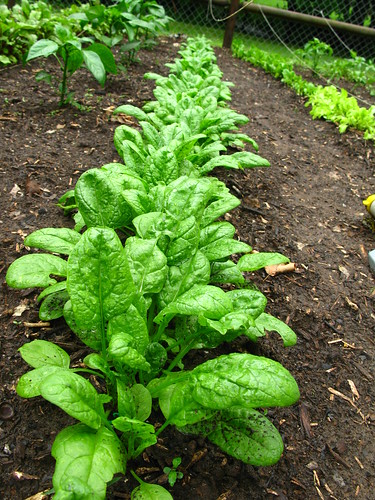 |
| Ready for Cooking originally uploaded by luckyjimmy |
This month, to celebrate the season and a healthy, colorful plate, all our recipes will be red and green, with an emphasis on leafy spinach greens.
Why Spinach?
 |
| Home Grown Spinach originally uploaded by OakleyOriginals |
Spinach is so rich in antioxidants and vitamins, the list is almost absurd. In fact, here it is: vitamins A, C, E, K, B2 & B6, magnesium, manganese, folate, betaine, iron, calcium, potassium, folic acid, copper, protein, phosphorus, zinc, niacin, selenium and omega-3 fatty acids. The best way to preserve the nutrients in spinach is to each it fresh, steamed or briefly boiled as prolonged boiling can reduce some of the nutrient content (although, really not enough to be too fussed about!).
You can buy spinach fresh (and often conveniently bagged as just rinse they're ready-to-eat leaves) or in frozen bags. Both forms take about the same amount of work and are just as good for you. Since frozen veggies are usually frozen very fresh, they often pack just as many nutrients, if not more, than the fresh greens in the produce section. I prefer to work with fresh spinach, but for most of the recipes this month, the frozen variety will do just as well.
Here are some great ways to start incorporating spinach into your meals and snacks:
 |
- Throw out the iceberg and make spinach your go-to salad green! You can add a small, restaurant-style side salad to every meal by quickly plopping some spinach leaves, onions and cherry tomatoes on your plate nestled up next to your entree. For larger salads, toss spinach in with green lettuce like romain or butterhead for a healthy, green mix.
- Spinach is a great addition to nearly every pasta. Throw it in with chicken alfredo or beefy tomato or bolognese dishes. Layer it into lasagne or bake it into your cannelloni or ravioli stuffing.
- Mix it with a little cheese and roll it into a variety of pastries such as cresents or puff pastries.
- Add spinach, cheese and ham/bacon to your eggs to make a hearty breakfast quiche, omelet or frittata.
- Next time you make a casserole, mix in some spinach. You might not even realize it's there!
- Add it to your pizza toppings.
- Layer it into a sandwich- especially a hot/grilled one.
- Don't forget to keep spinach dip on-hand for snacks and entertaining.
Happy Cooking!


No comments:
Post a Comment